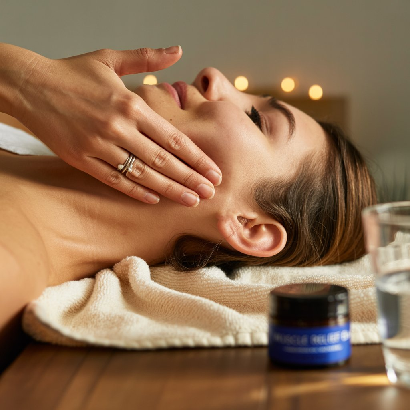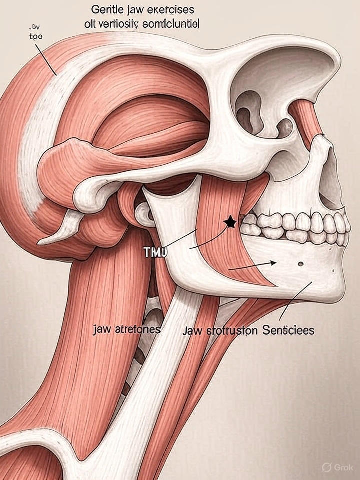Temporomandibular joint dysfunction, often called TMJ dysfunction or TMD, affects millions of people worldwide. If your jaw hurts, clicks, or feels stuck, you might have TMJ issues. The good news is that temporomandibular joint dysfunction self-care can help you feel better without needing complex treatments. In this article, I’ll share easy, natural ways to manage TMJ pain at home. Plus, I’ll include real-life examples, a case study, a helpful chart, and answers to common questions.
By the end, you’ll know how to take care of your jaw and reduce discomfort. So, let’s dive in and explore how you can start feeling better today!
Table of Contents
What Is Temporomandibular Joint Dysfunction?
First, let’s understand what TMJ dysfunction is. The temporomandibular joint connects your jaw to your skull. It acts like a hinge, letting you open and close your mouth. You use it when you talk, chew, or yawn. When this joint doesn’t work properly, it causes pain or discomfort, known as TMJ dysfunction.
For example, if you wake up with a sore jaw or hear a clicking sound when you eat, that’s a sign of TMJ issues. Many things can cause it, like stress, teeth grinding, or even chewing gum too much. However, temporomandibular joint dysfunction self-care can make a big difference in managing these symptoms.
Common Symptoms of TMJ Dysfunction
Next, let’s look at the signs of TMJ dysfunction. Knowing these helps you figure out if you need self-care. Here are some common symptoms:
- Jaw pain or tenderness
- Clicking or popping sounds in the jaw
- Trouble opening or closing your mouth
- Headaches or earaches
- Face or neck pain
If you notice these, don’t worry! Simple self-care steps can help. For instance, my friend Sarah had jaw pain for weeks. She started doing gentle jaw exercises and avoided hard foods. Soon, her pain was much better.
Why Temporomandibular Joint Dysfunction Self-Care Matters
Now, you might wonder why self-care is so important. Well, TMJ dysfunction can get worse if you ignore it. Pain might spread to your neck or head, making daily life harder. However, with temporomandibular joint dysfunction self-care, you can reduce pain and prevent bigger problems.
Moreover, self-care is easy and doesn’t cost much. You don’t always need a doctor or fancy treatments. By making small changes, like eating soft foods or managing stress, you can feel better. Let’s explore some of these self-care tips next.

Top 10 Temporomandibular Joint Dysfunction Self-Care Tips
Here are 10 simple ways to care for your jaw at home. Each tip is easy to follow, and together, they can bring relief.
- Eat Soft Foods to Rest Your Jaw
First, give your jaw a break by eating soft foods. Hard or chewy foods, like nuts or bagels, make your jaw work harder. Instead, try soups, yogurt, or mashed potatoes. For example, when my cousin Jake had TMJ pain, he switched to smoothies for a week. His jaw felt much better.
- Avoid Chewing Gum
Next, stop chewing gum. It keeps your jaw moving constantly, which can worsen TMJ pain. Instead, sip water or suck on a mint if you need something to do with your mouth. This small change can make a big difference.
- Practice Gentle Jaw Exercises
Also, try gentle jaw exercises to relax and strengthen your jaw. For instance, slowly open and close your mouth 10 times. Or, move your jaw side to side gently. These exercises improve movement and reduce stiffness. Check out this guide from the American Dental Association for more exercises.
- Use Heat or Cold Packs
Moreover, heat or cold packs can ease pain. A warm towel on your jaw relaxes muscles, while a cold pack reduces swelling. Try each for 10-15 minutes. For example, my neighbor Lisa uses a warm pack every evening, and it helps her jaw feel looser.
- Manage Stress to Reduce Teeth Grinding
Stress is a big cause of TMJ dysfunction because it makes you clench or grind your teeth. So, try stress-relief activities like deep breathing or yoga. For instance, I started meditating for 5 minutes a day, and it helped me stop clenching my jaw at night.
- Maintain Good Posture
Additionally, good posture helps your jaw. Slouching puts extra pressure on your neck and jaw. Sit up straight and keep your head aligned with your spine. This tip is simple but powerful for temporomandibular joint dysfunction self-care.
- Avoid Extreme Jaw Movements
Furthermore, avoid opening your mouth too wide, like when yawning or singing loudly. These movements strain your jaw. Instead, yawn gently or rest your chin on your hand to limit how wide your mouth opens.
- Sleep in a Comfortable Position
Also, your sleep position matters. Sleeping on your stomach can press on your jaw. Instead, sleep on your back with a supportive pillow. This reduces pressure and helps your jaw relax overnight.
- Stay Hydrated
Next, drink plenty of water. Dehydration can tighten muscles, including those in your jaw. Aim for 8 glasses a day. For example, my sister noticed less jaw pain after she started carrying a water bottle everywhere.
- Talk to a Dentist if Needed
Finally, if self-care doesn’t help after a few weeks, see a dentist. They can check for serious issues or suggest a mouthguard to stop teeth grinding. Visit Mayo Clinic’s TMJ page for more on when to seek help.
Real-Life Example: How Emma Managed TMJ Pain
Let me share Emma’s story to show how temporomandibular joint dysfunction self-care works. Emma, a 25-year-old teacher, started having jaw pain after a stressful school year. She noticed clicking sounds and couldn’t open her mouth wide. At first, she ignored it, but the pain got worse.
Then, Emma tried self-care. She ate soft foods, like oatmeal and soups, for two weeks. She also did jaw exercises every morning. To manage stress, she started walking for 20 minutes daily. Within a month, her pain was almost gone, and the clicking stopped. Emma’s story shows that small changes can lead to big relief.
Case Study: TMJ Self-Care in Action
Now, let’s look at a case study from a dental clinic. Dr. Smith, a dentist in Chicago, worked with a patient named Mark, aged 32. Mark had TMJ dysfunction from grinding his teeth at night. Dr. Smith suggested temporomandibular joint dysfunction self-care before trying a mouthguard.
Mark followed these steps:
- Ate soft foods for 10 days
- Used a warm pack twice daily
- Practiced jaw exercises
- Reduced stress with meditation
After three weeks, Mark’s pain dropped by 80%. He continued self-care and avoided needing costly treatments. This case shows how effective self-care can be.
Temporomandibular Joint Dysfunction Self-Care Chart
Here’s a handy chart to summarize self-care tips and their benefits. Keep it as a quick guide!
|
Self-Care Tip |
How It Helps |
How Often |
|---|---|---|
|
Eat soft foods |
Rests jaw muscles |
Daily for 1-2 weeks |
|
Avoid chewing gum |
Reduces jaw strain |
Always |
|
Gentle jaw exercises |
Improves movement, reduces stiffness |
2-3 times daily |
|
Heat or cold packs |
Relaxes muscles or reduces swelling |
10-15 min, 1-2 times daily |
|
Manage stress |
Stops teeth grinding |
Daily |
|
Good posture |
Reduces jaw and neck pressure |
Always |
|
Avoid extreme jaw movements |
Prevents joint strain |
Always |
|
Sleep on back |
Relaxes jaw overnight |
Nightly |
|
Stay hydrated |
Keeps muscles loose |
8 glasses daily |
|
See a dentist |
Checks for serious issues |
If pain lasts 2-3 weeks |

FAQs About Temporomandibular Joint Dysfunction Self-Care
Before we wrap up, let’s answer some common questions about TMJ self-care. These will help clear up any doubts.
What causes temporomandibular joint dysfunction?
TMJ dysfunction can come from stress, teeth grinding, jaw injuries, or arthritis. Chewing hard foods or bad posture can also contribute.
How long does TMJ self-care take to work?
Most people feel better in 1-3 weeks with consistent self-care. However, it depends on how severe your symptoms are.
Can I cure TMJ dysfunction with self-care alone?
Self-care often reduces symptoms, but severe cases might need a dentist’s help. Always check with a professional if pain persists.
Are jaw exercises safe for TMJ dysfunction?
Yes, gentle exercises are safe and helpful. Just don’t overdo it. Follow guides from trusted sources like the National Institute of Dental and Craniofacial Research.
Can stress really make TMJ worse?
Absolutely. Stress makes you clench or grind your teeth, which strains your jaw. Managing stress is key to temporomandibular joint dysfunction self-care.
Conclusion
Temporomandibular joint dysfunction self-care is a simple, effective way to ease jaw pain. By eating soft foods, doing gentle exercises, managing stress, and following other tips, you can feel better without complex treatments. Real stories like Emma’s and case studies like Mark’s show that these steps work.
So, why wait? Start with one or two self-care tips today. For example, try eating soft foods or using a warm pack. If you stick with it, you’ll likely notice less pain and more comfort soon. If symptoms don’t improve, don’t hesitate to see a dentist for extra help.
Take care of your jaw, and it’ll take care of you. Here’s to a pain-free smile!
